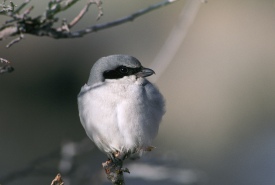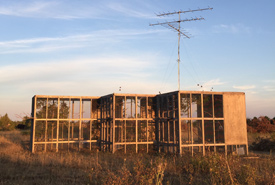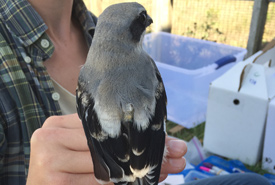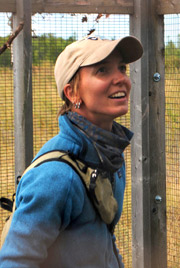Tracking eastern loggerhead shrikes

Eastern loggerhead shrike (Photo by Dave Menke, courtesy of USFWS)
Driving past the Nature Conservancy of Canada (NCC) Napanee Plain Alvar Nature Reserve, north of Napanee, Ontario, you might not notice anything overly special about the site. In fact, if you didn’t stop to have a closer look, you might not think this field is any different from others in the area. You might be surprised, then, to find that this unassuming pasture has become one of the most important sites in the province for the conservation and recovery of one of Canada’s most endangered songbirds: the eastern loggerhead shrike.
The Napanee Plain Alvar Nature Reserve is one of the very few areas of grassland and alvar habitat protected in the region, thanks to NCC. It’s a site where wild loggerhead shrikes have been nesting for the last decade, not to mention other grassland species at risk, including bobolink and eastern meadowlark. In an area where grassland habitat is increasingly being lost, either when pastures are converted for agriculture or through development, this swath of protected habitat is invaluable to the native wildlife in the region, as well as to Wildlife Preservation Canada’s Loggerhead Shrike Recovery Program.

A radio telemetry tower sits on top of the specially designed shrike flight cages. The tower will detect any tagged birds that fly nearby. This tower is part of a network of hundreds of towers across North America. (Photo by Wildlife Preservation Canada)
Five years ago Wildlife Preservation Canada’s Loggerhead Shrike Recovery Program started releasing captive-bred shrikes at the Napanee Plain Alvar Nature Reserve. Six field seasons, 10 biologists and hundreds of hours of field work later, this site has seen 240 juvenile shrikes released into the wild. These birds are part of a conservation breeding program that is a key part of shrike recovery in Ontario, and will help to bolster the wild population while researchers work on figuring out why shrikes started disappearing and how we can fix it.
These captive-bred birds are also instrumental in answering one of the biggest questions around Ontario’s shrike population: Where do they go in the winter?
It seems a simple question, but has proven very difficult to answer. We’ve been colour banding our birds before release, in the hopes that intrepid birders will see these bands and report their sightings to us. Despite hundreds of birds banded, reported sightings have been relatively few. We’re still optimistic that the colour banding will lead to insights into their mysterious winter migration.
Lately, we’ve been turning to a more high-tech approach by using radio tags to track our birds as they move. These tags are tracked on the Motus Wildlife Tracking System, a growing, collaborative network of radio telemetry towers designed to detect wildlife movements. The radio tags, which weigh less than a dime and are attached to a bird by a stretchy harness, will allow us to detect an individual whenever they pass within range of an antenna. In 2016, we put up a telemetry tower on one of the release cages on the Scheck Nature Reserve, and we’ve been able to see when our tagged birds start migrating. After that, it’s a waiting game to see where else our birds will show up.

An eastern loggerhead shrike fitted with a radio telemetry tag. The tag weighs only two grams (the weight of a dime) and is barely noticed by the bird. (Photo by Wildlife Preservation Canada)
So far, we’ve been able to track seven birds released at the Napanee Plain Alvar Nature Reserve, and have seen birds going both east and west around the Great Lakes before passing in to the United States. Why did some shrikes take the long way around? Where will they end up? These are questions we hope to answer as more data are collected, and the network expands through more of our shrikes’ potential winter range.
About Wildlife Preservation Canada
Established in 1985, Wildlife Preservation Canada is a national charity devoted to saving endangered animal species facing imminent extinction in Canada — species whose numbers in the wild are so low that habitat protection alone is not enough. It is currently providing expert hands-on care to several reptile, amphibian, bird and insect species in projects ranging from the St. Lawrence/Great Lakes region to Vancouver Island, making it the only organization in Canada to perform such work in multiple species recovery efforts across the country.


